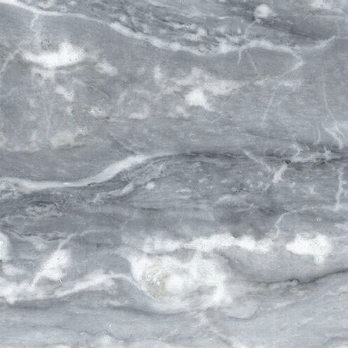Bardiglio Nuvolato
marble
Petrografic name (according EN 12407): Marble
Category: bardiglio
colour: Grey
Macroscopic description: An aphanitic, compact dark grey lithotype with a cloudy appearance due to the presence of lighter-coloured flames and patches on a dark background. Abundant darkish veins occur that are submillimetric in size with a parallel orientation. These are very close to one another in places and anastomosed, forming dark grey sub centimetric bands. There are rare plurimillimetric sub rounded patches that are also dark grey in colour. The material has no surface porosity.
Technical data provides a frame of reference only. As stone is a product of nature, up to date testing to determine specific physical qualities should be repeated for each major project. We decline any responsability for the mis-use of this data, since said data is sourced from the quarry.
Physical mechanical characteristics
| STANDARD | U.M. | MEAN VALUE | ST. DEV. | |
 EN 13755-08 EN 13755-08 |
Water absorption at atmospheric pressure | % | 1,15 | 0,02 |
 EN 1936-07 EN 1936-07 |
Apparent Density | KG/m3 | 2700 | 0 |
 EN 1936-07 EN 1936-07 |
Open porosity | % | 0,4 | 0,04 |
 EN 12372-07 EN 12372-07 |
Flexural strength | |||
| (in natural conditions) | MPa | 13,5 | 1,4 | |
| (EN 12371-03 exposed to 48 frost cycles | MPa | 10,7 | 1,6 | |
 EN 1926-07 EN 1926-07 |
Uniaxial compressive strength | MPa | 102,4 | 6,5 |
 EN 14231-04 EN 14231-04 |
Slip resistance (honed finishing) | |||
| (dry) | USRV | 66 | 2 | |
| (wet) | USRV | 31 | 1,5 | |
Block and slab characteristics
Average size of blocks: 3,00 x 1,70 x 1,70m.
Slabs are preferably cut against the grain or perpendicular to the grain, i.e. the hard way and the easy way.
 Cutting of blocks
Cutting of blocks  Surface lavoration
Surface lavoration
 Cutting of blocks
Cutting of blocks  Surface lavoration
Surface lavoration
Microscopic description according to EN 12407 e EN 12460
| A crystalloblastic metamorphic lithotype with calcite crystals that are seriate in size between 50 and 400uÌm, subeuhedral/euhedral with mainly straight or rounded/sutured boundaries, and patches and veins. The areas that macroscopically appear lighter in colour are composed of very fine-grained calcitic crystals (< 50 um), that are generally clear, associated with larger-sized blasts (250 um) clouded by abundant opaque minerals and in places accompanied by iso-orientated acicular muscovite, pyrite, quartz (of a maximum size of 850 um) and trace amounts of feldspar. The darker veins, clearly iso-orientated, are composed of abundant magnetite in glomerules (200 um) associated with green phyllosilicates and rare hematite, limonite, chlorite, tourmaline, quartz and dolomite. |




